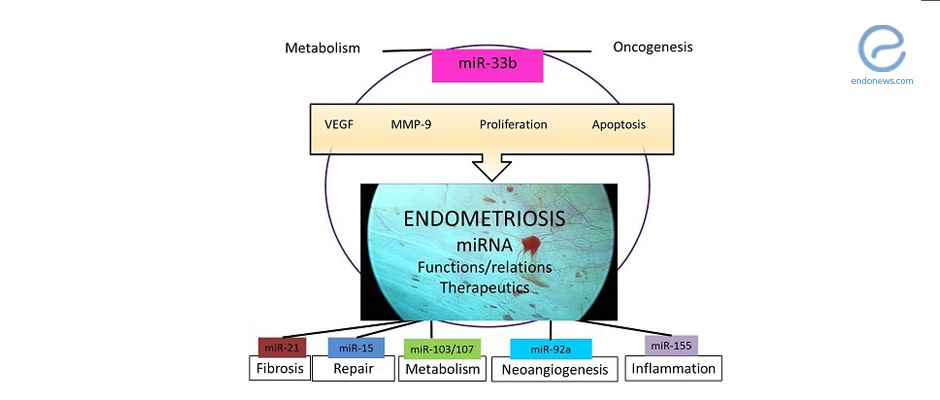The Potential Molecular Mechanisms that Drive Endometriosis Progression
Aug 7, 2017
MiR-33b expression and its subsequent impact on the activity of related factors can potentially lead to endometriosis.
Key Points
Highlights:
- This study wishes to elucidate the molecular mechanism that drives endometriosis progression. It is hypothesized that miR-33b, a microRNA, plays a role in the pathogenesis of this disease.
Importance:
- The mechanism that causes endometriosis is still unknown. Understanding the molecular mechanism can help in better understanding the nature of the disease, and it can lead to the creation of treatments and therapies for those with the illness.
What's done here?
- The researchers collected tissues from women with endometriosis and from women who had other uterine abnormalities. These tissues were subject to Real-time PCR to identify miR-33b levels.
- These tissues were then cut, digested, and centrifuged. The resulting cells treated with either a miR-33b mimic or inhibitor. After a period of incubation, the cells were analyzed.
- miR-33b expression and its impact on the expression of growth factors such as vascular endothelial growth factor (VEGF) and matrix metalloprotein 9 (MMP-9) were evaluated.
- Cell proliferation and programmed cell death were also examined.
Key results:
- The miR-33b expression is less in the endometrial tissue of patients with endometriosis.
- The use of miR-33b mimics and inhibitors proved that increased miR-33b activity is linked with an upregulation of apoptosis and a down-regulation of growth factors.
- As far as miR-33b controls cell proliferation and apoptosis the authors suggest that when downregulated it is unable to control the endometrial cells in the uterus, result in endometriosis.
Limitations of the study:
- This experiment is conducted on specimens outside the body (in-vitro). It is not possible to perfectly recreate the conditions of the human body and analyze the specimens within that environment.
- Although levels change parallelly, a direct causal relationship has not proven.
- Other reasons which may alter these biological molecules are not well known and not examined.
Lay Summary
Endometriosis is a mysterious disease in that the exact mechanism that causes the illness is still at large. Yang et al. recently published a paper in the European Review for Medical and Pharmacological Sciences that hopes to elucidate the molecular means by which Endometriosis comes to be. In their publication titled “Regulation of miR-33b on endometriosis and expression of related factors,” they hypothesize that miR-33b, a type of mi-RNA, could be a part of this elusive mechanism.
The researchers collected endometrial tissues from patients with endometriosis and patients with other uterine abnormalities. The cells from the tissues were cultured and subject to either a miR-33b mimic or inhibitor. Next, the cells analyzed for miR-33b expression using Real-time PCR. The impact miR-33b expression had on vascular endothelial growth factor (VEGF), and matrix metalloprotein 9 (MMP-9) expression was determined using Western Blot and Real-time PCR. Cell proliferation and Caspase 3 activity were measured using MTT and a test kit respectively.
Overall, it was seen that individuals with endometriosis have less miR-33b in their endometrial tissue. Additionally, the results showed that miR-33b is responsible in part for the upregulation of Caspase 3 activity and the down-regulation of VEGF and MMP-9. Inhibition of miR-33b resulted in decreased Caspase 3 activity and increased VEGF and MMP-9 activity.
The authors of the study believe that miR-33b has a role in apoptosis and cell proliferation. When miR-33b is not present or not present in adequate amounts, it is unable to control the life and death of endometrial cells, and eventually, might result in endometriosis.
Research Source: https://www.ncbi.nlm.nih.gov/pubmed/28537685
miR-33b mi-RNA VEGF MMP-9 Caspase 3 activity pathogenesis Real-time PCR MTT Western Blot proliferation apoptosis pathogenesis uterine abnormalities RNA

